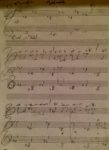Stepping Off The Page: Nocturne in Eb Major
 Deanna Witkowski is an active pianist and composer, has 5 albums to her credit, and currently holds the piano chair in the BMI/New York Jazz Orchestra. She won the Great American Jazz Competition in 2002. Deanna is passionate about improvising and is excited about this opportunity to connect with all of you. In this column she will teach and discuss improvisation in a broader context than just jazz and do it so all you piano addicts, no matter your level, can have some fun with the ideas she posts.
Deanna Witkowski is an active pianist and composer, has 5 albums to her credit, and currently holds the piano chair in the BMI/New York Jazz Orchestra. She won the Great American Jazz Competition in 2002. Deanna is passionate about improvising and is excited about this opportunity to connect with all of you. In this column she will teach and discuss improvisation in a broader context than just jazz and do it so all you piano addicts, no matter your level, can have some fun with the ideas she posts.
Welcome to the inaugural edition of Stepping Off the Page! I’m excited to welcome you to this new monthly column that will explore various ways to incorporate improvisation into your piano studies, whether you are a novice or a seasoned player.
Some of you may know, from my recent Piano Addict Artist Portrait, that I have a new solo recording, Raindrop: Improvisations with Chopin. On Raindrop, I do exactly what the title implies: I improvise and arrange eight of Chopin’s nocturnes, preludes, and etudes. The first track is a piece that probably all of you know: Chopin’s Nocturne in E-flat major, Op. 9, no. 2. In this first column, I’m going to show you how I approached improvising with this piece- and how you can use similar principles to improvise with whatever piece you might be currently working on.
To guide us as we go along, here is a pdf of the full nocturne, along with some sectional and chord markings: http://deannawitkowski.com/wp-content/uploads/2015/07/Chopin-Nocturne-in-E-flat-maj-with-markups.pdf
Here is also a related YouTube video, where I demonstrate how I improvised on this nocturne: http://youtu.be/P1kU_Dii6kc
Here are three basic principles to use when improvising on any piece:
- Find out as much as you can about what gives the particular piece you’re working on its unique sound. In other words, analyze the piece, or at least part of it. Here’s a list of some characteristics of this nocturne:
- Left hand has repeated triplet figures throughout.
- The structure of the melody is: A (4 bars), A, B (4 bars), A, B, A, C. If I break this down, the first 16 bars are very similar to many jazz standards that have an AABA form! And since all of the A and B sections are four-bar phrases, they give me many chances to improvise within the structure of the piece.
- There are a lot of embellishments each time an A or B section is repeated.
- I’ve analyzed the chord structure of the A and B sections on the attached pdf. Notice that the B section begins on the dominant chord (as opposed to the A section, which begins and ends on the tonic). The B section’s left hand also moves down chromatically for two bars, giving it a very different feel from the A section.
- All of the melodies (minus the ornamentation) are singable, and are within the space of a ninth. We can use this concept in our improvising.
- Take one of the characteristics of the piece: let’s look at the chord progression for the first four bars (see the pdf).
Keeping the left hand intact (and thus, keeping the shell of the chords intact), try improvising a new melody using only notes from the E-flat major scale in your right hand.
- Give yourself different parameters within which to improvise:
Often note choices (both in terms of pitch and rhythm) can seem overwhelming, so give yourself different limits each time you improvise. For instance: try keeping your right hand melody within the space of an octave: i.e., from B-flat above middle C to B-flat two octaves above middle C.
Another option: You’ll notice that Chopin adds more sixteenth notes in his second statement of the A section. So, limit yourself to using eighths, quarters, dotted quarters, and dotted half notes in your improvisation.
In my arrangement, I alternated between the written material and improvisations. This particular piece is a great one for improvising because the A and B sections are so clearly delineated, and are four bars each time.
You might decide that you want to keep a melodic element intact and change the chord progression. I did this in the very last two bars of this piece. Here’s a sheet music pdf that shows exactly what I played:
The great thing about improvising on any piece of music is that it allows you the opportunity both to get to know the original piece more fully and to try to bring something new to your practice.
How are you improvising with this Chopin nocturne, or with other pieces? Let Deanna know in the comments below, through Piano Addict’s Facebook, Twitter or Google+ feeds, or by sending a note to deannajazz@gmail.com. And to hear more material from Raindrop: Improvisations with Chopin, visit deannajazz.com.


